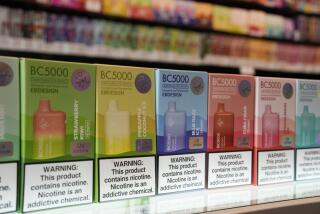Ruling Opens Door to Firms’ Deepest Fear
- Share via
Friday’s historic court ruling upholding the government’s authority to regulate tobacco products as drug-delivery devices affirmed cigarette makers’ deepest fear: that they ultimately may be compelled to reduce or even eliminate nicotine, the ingredient that has transformed millions of youths into decades-long customers.
Restrictions on nicotine would make it easier for smokers to quit and harder for new users to get hooked, thus cutting tobacco sales and profits.
The ruling by U.S. District Judge William L. Osteen Sr. technically was a split decision that upheld the Food and Drug Administration’s authority to regulate the $50-billion industry, while striking down new advertising restrictions aimed at cutting sales to people younger than 18. Although industry spokesmen hailed that part of the ruling, the marketing restrictions were but a secondary worry for cigarette makers.
Indeed, in recent negotiations aimed at settling its enormous liability problems, the industry has indicated that it would accept restrictions on marketing and advertising--including giving up such potent marketing symbols as the Joe Camel character--and more, to get out from under an avalanche of lawsuits.
The tobacco companies’ worst nightmare all along has been that the FDA, after getting its foot in the door, might compel them to re-engineer tobacco products to reduce or eliminate nicotine, which could lead to dramatic increases in the number of smokers who succeed in quitting.
Indeed, by establishing an ambitious goal for cutting youth smoking--but taking only modest steps to achieve it--the FDA had set the stage for a future attack on nicotine levels. Backed by President Clinton, the agency declared a goal of reducing tobacco use by underage youths by 50% during the next seven years.
Despite the country’s growing anti-tobacco mood, teen smoking is on the rise, and few people believe that billboard restrictions and similar moves could cut youth smoking in half. When the marketing curbs fall short, the government could declare that approach a bust and go after nicotine content.
*
That’s why Friday’s decision was such a victory for anti-smoking advocates, said Jack E. Heningfield, the former chief of clinical pharmacology at the National Institute on Drug Abuse and now an associate professor at Johns Hopkins Medical School.
“Authority to regulate is the cake; everything else is details,” Heningfield said. “If the FDA has the authority to reduce youth smoking in seven years and can’t do it with advertising restrictions, they have the authority to do it some other way,” he added.
Whether smoking is considered an addiction or a habit, research has shown that a large majority of smokers would like to quit but have found it extremely hard or even impossible to do so. Some people enjoy the act of smoking and might at least occasionally light up a non-nicotine smoke. But if the impact of nicotine were blunted, thereby reducing the physical craving, sales could be dramatically cut.
During the next two weeks, anti-smoking members of Congress plan to introduce legislation directing the FDA to ratchet down nicotine in cigarettes during the next five years until the level would be minimal. A similar bill failed last year, and tobacco supporters in Congress should be able to block this one. But the Osteen ruling, if it survives expected appeals, means that the FDA could tinker with nicotine levels without being told to do so by Congress.
In the short run, the ruling also should strengthen the hand of anti-tobacco plaintiffs in their talks with industry negotiators aimed at settling more than 300 lawsuits, including multibillion-dollar health care cost recovery claims by two dozen states and about 20 massive class-action suits.
Indeed, they emphasized that the huge psychological boost that came with a favorable ruling from a court in the tobacco stronghold of Greensboro, N.C., a forum chosen by the defendants, who could have challenged the FDA rules anywhere they wished.
Connecticut Atty. Gen. Richard Blumenthal called it “an extraordinary event for a judge in tobacco country to say that tobacco products fit the definition of a drug. . . . This devastating defeat to the tobacco industry should strengthen our hand in the courtroom and at the bargaining table.”
But Charles Blixt, R.J. Reynolds Tobacco Co.’s senior vice president and general counsel, scoffed at that contention.
“If I were representing an attorney general, I don’t know how I could conclude that a finding by a court that all of the regulatory proposals by the FDA concerning advertising are invalid would enhance my position,” Blixt said.
Blixt would not comment on the negotiations, and lawyers bargaining for the industry did not return phone calls.
In a report issued just before the decision, Gary Black, a prominent tobacco analyst with the investment firm Sanford C. Bernstein & Co., said a ruling that upheld the FDA’s authority to regulate the industry while rejecting the advertising curbs “would be a disappointment, although the industry would likely claim victory.”
Sure enough, Brown & Williamson Tobacco Corp., the third-largest U.S. cigarette maker, issued a statement declaring that it was “very pleased with the decision. . . . We won today on the major commercial issue, which was our right to freely advertise and promote our products to adult consumers,” the company said.
However, tobacco stockholders were not so sanguine Friday, driving down prices of major cigarette makers.
In the settlement talks, tobacco companies are seeking protection from lawsuits and restrictions on FDA authority over cigarette design. Any deal reached with anti-tobacco plaintiffs would have to be approved by Congress, as it would restrict the legal rights of people to sue the industry and might limit the options of the FDA. As part of the settlement under discussion, the industry would also establish a fund to reimburse states for smoking-related health care costs and to compensate sick smokers.
Trial balloons floated during the secret talks have put the size of the fund at up to $300 billion, to be paid over 25 years. On Friday, Black said that in the wake of the Osteen ruling, “the costs of a settlement may be higher” than the industry previously anticipated.
More to Read
Sign up for Essential California
The most important California stories and recommendations in your inbox every morning.
You may occasionally receive promotional content from the Los Angeles Times.













